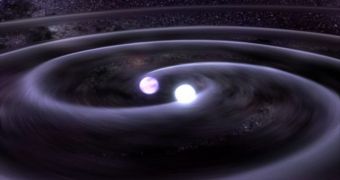A team of technologists at the NASA Goddard Space Flight Center (GSFC), in Greenbelt, Maryland was recently awarded Phase-2 funding by the space agency's Innovative Advanced Concepts (NIAC) program, for continuing their development of an atom interferometer.
Such a device has never been constructed before. Theoretically, it should be able to detect tiny variations in the space-time curvature, which are hypothesized to occur as gravitational waves fly past.
These structures were first proposed by Albert Einstein as a consequence of his theory on general relativity. Thus far, scientists have not been able to develop instruments sensitive enough to detect these waves, which are believed to be produced by the interactions of extremely-dense objects.
For example, astrophysicists believe that a pair of merging black holes or neutron stars could easily produce gravitational waves. These would manifest themselves as ripples in space-time, similar to the ones occurring on the surface of a lake after the waters are disturbed by a falling rock.
Since gravitational waves are spaced extremely far apart, and produce only minor variations in space-time, scientists need to come up with innovative detection systems. An atom interferometer is one of the methods proposed for detecting such waves, primarily because the instrument features picometer-level sensitivity.
A picometer is a unit of measurement equal to one trillionth of a meter, or one millionth of a micrometer. To get a sense of just how small that is, consider the fact that most atoms are between 62 and 520 picometers in diameter.
The new instrument would function by detecting minute changes in the position of individual atoms. If an atom in its field of view changes location by as much as a picometer, the interferometer will be able to detect this. If launched in space, this devices may be able to finally identify gravitational waves.
GSFC executive Bernie Seery, who leads the atom interferometer development team, says that the instrument has other applications besides detecting gravitational waves. He believes that such interferometers could be successfully used in the field of geodesy to produce highly detailed results.
In addition, spacecraft outfitted with such a sensor could conduct accurate Earth sciences investigations, potentially providing additional insights into the planet's water cycle, global warming patterns and overall climate change.

 14 DAY TRIAL //
14 DAY TRIAL //